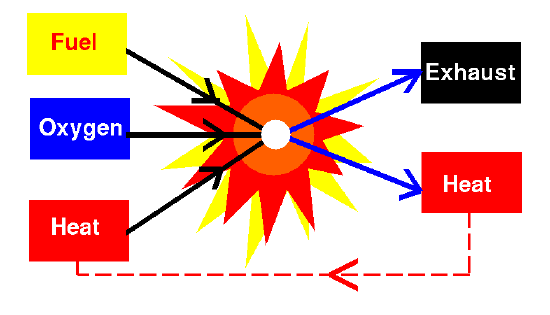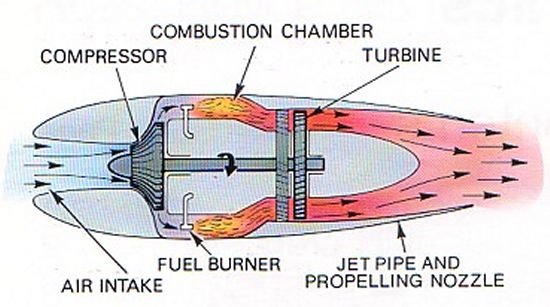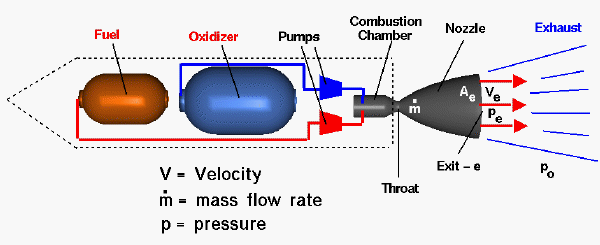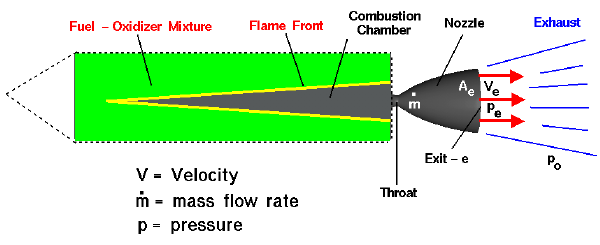| المجموعات الإجتماعية |
| البحث |
| مشاركات اليوم |
 |
| دروس تقنية وصيانة الطائرات يقديم شروح لمنظومات الطائرة تعرض على شكل دروس بطريقة اكاديمية مبسطة |
| إضافة رد |
|
|
أدوات الموضوع |
 |
| دروس تقنية وصيانة الطائرات يقديم شروح لمنظومات الطائرة تعرض على شكل دروس بطريقة اكاديمية مبسطة |
| إضافة رد |
|
|
أدوات الموضوع |
| مشاركة [ 1 ] | ||||
|
||||
|
|
 In order to understand how an engine works, we first need to understand the process of combustion. Combustion is defined as the burning, or oxidation, of matter to produce energy. Two substances are necessary for combustion to occur--a fuel and an oxidizer. A fuel can be anything from the wood, coal, or natural gas used to produce heat in a furnace to gasoline or hydrogen used in an internal combustion engine. An oxidizer, as its name implies, is a substance that contains oxygen.  The purpose of both the jet engine and the rocket engine is to combust a mixture of fuel and oxidizer. This combustion process generates a high-pressure exhaust that creates thrust to push a vehicle forward. The fundamental difference between the two types of engines, however, is where the oxidizer comes from. A jet engine obtains its oxidizer from the external atmosphere, as illustrated in the diagram below. Air enters the engine through an inlet and is then slowed down and compressed by a series of compressor blades. The compressed air is then mixed with fuel, typically a petroleum-based liquid similar to kerosene, and burned. The high-pressure gas is exhausted through a nozzle to generate thrust.  A rocket engine differs from a jet engine primarily in one key way. Whereas the jet pulls in oxidizer from the atmosphere, a rocket carries its own supply of oxygen aboard the vehicle. An example shown below is the liquid rocket engine. This class of rocket carries a liquid fuel and a liquid oxidizer in two separate tanks. The two liquids are pumped into a combustion chamber at some rate, called the mass flow rate, where they are mixed and burned. Just as in the jet engine described earlier, this combustion process generates a high-pressure gas that is exhausted through a nozzle to generate thrust.  There are many different combinations of liquids that can be combusted in liquid rockets. One of the more common combinations, however, is liquid hydrogen as the fuel and liquid oxygen as the oxidizer. Other common fuels include kerosene and hydrazine while a frequently used oxidizer is nitrogen tetroxide. Liquid rockets are most commonly used on large vehicles that launch payloads into space, like the American Delta and Titan, Russian Soyuz and Proton, and European Ariane rockets. Another major form of the rocket is the solid rocket motor, like that illustrated below. A solid rocket also carries both the fuel and oxidizer aboard the vehicle. The difference between a solid rocket and a liquid rocket, however, is that the fuel and oxidizer are mixed together and cast into a solid mass. This mixture is inert and does not burn under normal conditions. When exposed to a heat source, like an igniter, however, a flame travels along the surface of the solid and combusts the mixed fuel and oxidizer. Once started, this reaction cannot be stopped, and the flame front will continue combusting the solid fuel until none remains.  Because they are so much easier to handle and store for long periods of time, solid rockets are commonly used on military missiles like Minuteman, AMRAAM, and HARM. The rocket motors that you and I can purchase in a store and use to launch model rockets are also solid rockets. However, while solid rockets are typically safer, they are usually not as powerful or efficient as their liquid cousins. Another advantage of liquid rockets is that they can also be throttled by slowing or increasing the rate at which fuel is combusted. A solid rocket, by comparison, cannot be stopped once ignited. For these reasons, a number of hybrid classes of rockets have been developed to take advantage of the strengths of each type. The aptly named hybrid rocket is a cross between a solid rocket and a liquid rocket. This type of rocket combusts a solid fuel using a liquid or gaseous oxidizer stored in a tank aboard the vehicle. The chief advantage of the hybrid rocket is the relative safety of the solid rocket, but the rocket can be throttled by adjusting the flow rate of the oxidizer. A similar device is the ducted rocket, which is a cross between a jet engine a solid rocket. The ducted rocket works in the same way as the hybrid rocket except that the oxygen is taken from the external atmosphere, like a jet, instead of carried aboard the vehicle. Calling such a device a "rocket" is a little confusing since we have already said that a rocket carries its own supply of oxidizer, but that is the name this class of propulsion system has been given. The ducted rocket is attractive as a potential booster for high-speed military missiles, but few such designs have entered service so far. To summarize, the primary difference between a jet and a rocket is that a rocket carries its own supply of oxygen internally while a jet must obtain oxygen from the external atmosphere. Another more technical way to explain this difference is that the fluid a jet engine accelerates to produce thrust is air from the atmosphere whereas the fluid a rocket accelerates to produce thrust is the exhaust from its own combustion process. It is for this reason that a rocket works in the vacuum of space, where there is no atmosphere, while a jet engine will not
 |
|||
|
|

|
| مشاركة [ 2 ] | ||||
|
||||
|
|
شكرا لك أخي على موضوعك الجميل
وبارك الله فيك لما تقدمه للمنتدى من موضوعات تحياتي |
|||
|
|

|
| مشاركة [ 3 ] | |||
|
|||
|
عضو خط الطيران
|
شكرا جزيلاً لك اخي .... فلقد اصبحت امتلك فكره جيده نوعا ما عن jet engine وانواع هذه المحركات ( Prop , fan ) بعد تتبع الرابط الموجود في الموضوع
لكن للأسف لم تكتمل الصوره تماما بالنسبة لي عن turboshaft بارك الله بكم |
||
|
|

|
| مشاركة [ 4 ] | ||||
|
||||
|
|
لكن للأسف لم تكتمل الصوره تماما بالنسبة لي عن turboshaft بارك الله بكم  تفضل الرابط التالي: موسوعة خط الطيران - محركات الطائرات وأي كلمة باللون الأخضر - أضغط عليها فسوف توصلك إلى شرح أكثر عن تلك المعلومة |
|||
|
|

|
| مشاركة [ 5 ] | ||||
|
||||
 |
جزاكم الله خير على التوضيح بين المحركين
واشكر الاستاذ ابو عبدالله على اضافه الروابط الاخرى تحياتي |
|||
|
|

|
| مشاركة [ 6 ] | ||||
|
||||
|
|
يعطيكم العافية عالمجهود الرائع وتقبل ودي واحترامي
|
|||
|
|

|
| مشاركة [ 7 ] | ||||
|
||||
|
|
حياك الله كابتن طارق
شاكرين لك الموضوع المتميز والشكر موصول للاخ ابو عبدالله لاضافته الرابط بارك الله فيكم جميعا تقبلوا تحياتي مع الود |
|||
|
|

|
| مشاركة [ 8 ] | ||||
|
||||
|
|
[QUOTE=libyan-ame;588333]شكرا لك أخي على موضوعك الجميل
وبارك الله فيك لما تقدمه للمنتدى من موضوعات تحياتي بارك الله فيك أخي الكريم libyan-am وشكراً لك علي مرورك نحن تلاميزكم مع ودي |
|||
|
|

|
| مشاركة [ 9 ] | ||||
|
||||
|
|
[QUOTE=AnasD;588491]شكرا جزيلاً لك اخي .... فلقد اصبحت امتلك فكره جيده نوعا ما عن jet engine وانواع هذه المحركات ( Prop , fan ) بعد تتبع الرابط الموجود في الموضوع
لكن للأسف لم تكتمل الصوره تماما بالنسبة لي عن turboshaft بارك الله بكم شكراً لك أخي الكريم علي المرور
وبارك الله فيك |
|||
|
|

|
| مشاركة [ 10 ] | ||||
|
||||
|
|
[QUOTE=Abo Abdullah;588507]جزاكم الله خير على التوضيح بين المحركين
واشكر الاستاذ ابو عبدالله على اضافه الروابط الاخرى تحياتي مشكور أخي الكريم علي المرور
مع خالص أمنياتي |
|||
|
|

|
| مشاركة [ 11 ] | ||||
|
||||
|
|
[QUOTE=ملازم طيار;588510]
يعطيكم العافية عالمجهود الرائع وتقبل ودي واحترامي
ولك مني كل الود والأحترام أخي الفاضل مشكور علي المرور |
|||
|
|

|
| مشاركة [ 12 ] | ||||
|
||||
|
|
[QUOTE=عماد المشهداني;588531]
حياك الله كابتن طارق
شاكرين لك الموضوع المتميز والشكر موصول للاخ ابو عبدالله لاضافته الرابط بارك الله فيكم جميعا تقبلوا تحياتي مع الود شكراً لك معلمنا الغالي عماد علي المرور تقبل خالص تحياتي مع ودي لك |
|||
|
|

|
| مشاركة [ 13 ] | ||||
|
||||
|
|
 In order to understand how an engine works, we first need to understand the process of combustion. Combustion is defined as the burning, or oxidation, of matter to produce energy. Two substances are necessary for combustion to occur--a fuel and an oxidizer. A fuel can be anything from the wood, coal, or natural gas used to produce heat in a furnace to gasoline or hydrogen used in an internal combustion engine. An oxidizer, as its name implies, is a substance that contains oxygen.  Simple representation of the combustion process The purpose of both the jet engine and the rocket engine is to combust a mixture of fuel and oxidizer. This combustion process generates a high-pressure exhaust that creates thrust to push a vehicle forward. The fundamental difference between the two types of engines, however, is where the oxidizer comes from. A jet engine obtains its oxidizer from the external atmosphere, as illustrated in the diagram below. Air enters the engine through an inlet and is then slowed down and compressed by a series of compressor blades. The compressed air is then mixed with fuel, typically a petroleum-based liquid similar to kerosene, and burned. The high-pressure gas is exhausted through a nozzle to generate thrust.  Schematic of a simple jet engine A rocket engine differs from a jet engine primarily in one key way. Whereas the jet pulls in oxidizer from the atmosphere, a rocket carries its own supply of oxygen aboard the vehicle. An example shown below is the liquid rocket engine. This class of rocket carries a liquid fuel and a liquid oxidizer in two separate tanks. The two liquids are pumped into a combustion chamber at some rate, called the mass flow rate, where they are mixed and burned. Just as in the jet engine described earlier, this combustion process generates a high-pressure gas that is exhausted through a nozzle to generate thrust.  Schematic of a liquid rocket engine There are many different combinations of liquids that can be combusted in liquid rockets. One of the more common combinations, however, is liquid hydrogen as the fuel and liquid oxygen as the oxidizer. Other common fuels include kerosene and hydrazine while a frequently used oxidizer is nitrogen tetroxide. Liquid rockets are most commonly used on large vehicles that launch payloads into space, like the American Delta and Titan, Russian Soyuz and Proton, and European Ariane rockets. Another major form of the rocket is the solid rocket motor, like that illustrated below. A solid rocket also carries both the fuel and oxidizer aboard the vehicle. The difference between a solid rocket and a liquid rocket, however, is that the fuel and oxidizer are mixed together and cast into a solid mass. This mixture is inert and does not burn under normal conditions. When exposed to a heat source, like an igniter, however, a flame travels along the surface of the solid and combusts the mixed fuel and oxidizer. Once started, this reaction cannot be stopped, and the flame front will continue combusting the solid fuel until none remains.  Schematic of a solid rocket motor Because they are so much easier to handle and store for long periods of time, solid rockets are commonly used on military missiles like Minuteman, AMRAAM, and HARM. The rocket motors that you and I can purchase in a store and use to launch model rockets are also solid rockets. However, while solid rockets are typically safer, they are usually not as powerful or efficient as their liquid cousins. Another advantage of liquid rockets is that they can also be throttled by slowing or increasing the rate at which fuel is combusted. A solid rocket, by comparison, cannot be stopped once ignited. For these reasons, a number of hybrid classes of rockets have been developed to take advantage of the strengths of each type. The aptly named hybrid rocket is a cross between a solid rocket and a liquid rocket. This type of rocket combusts a solid fuel using a liquid or gaseous oxidizer stored in a tank aboard the vehicle. The chief advantage of the hybrid rocket is the relative safety of the solid rocket, but the rocket can be throttled by adjusting the flow rate of the oxidizer. A similar device is the ducted rocket, which is a cross between a jet engine a solid rocket. The ducted rocket works in the same way as the hybrid rocket except that the oxygen is taken from the external atmosphere, like a jet, instead of carried aboard the vehicle. Calling such a device a "rocket" is a little confusing since we have already said that a rocket carries its own supply of oxidizer, but that is the name this class of propulsion system has been given. The ducted rocket is attractive as a potential booster for high-speed military missiles, but few such designs have entered service so far. To summarize, the primary difference between a jet and a rocket is that a rocket carries its own supply of oxygen internally while a jet must obtain oxygen from the external atmosphere. Another more technical way to explain this difference is that the fluid a jet engine accelerates to produce thrust is air from the atmosphere whereas the fluid a rocket accelerates to produce thrust is the exhaust from its own combustion process. It is for this reason that a rocket works in the vacuum of space, where there is no atmosphere, while a jet engine will not  thank you very much for your effort
|
|||
|
|

|